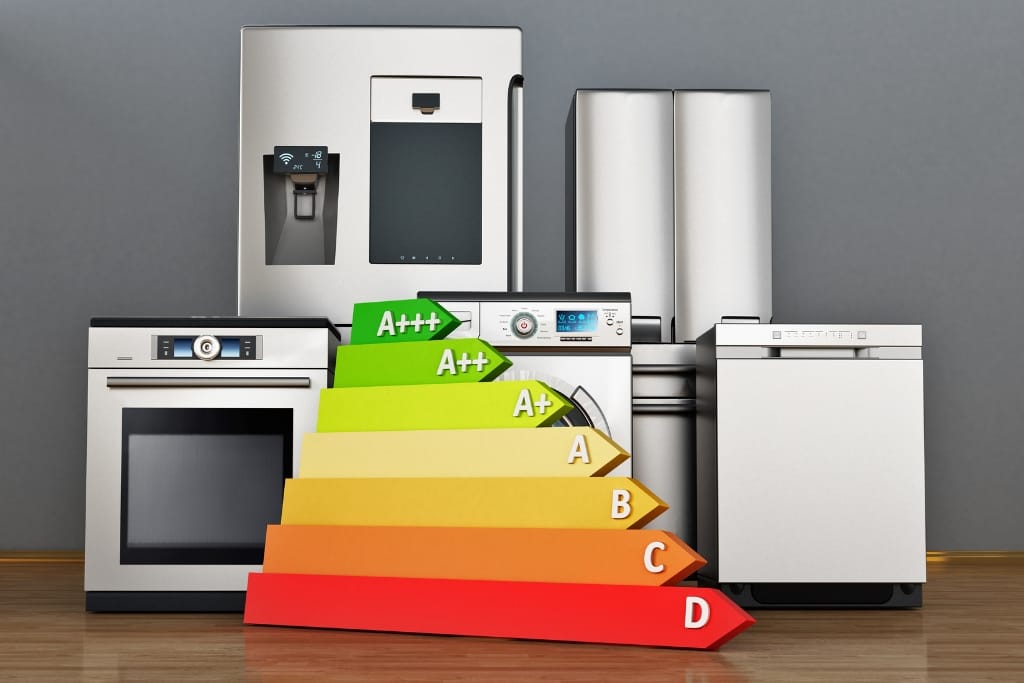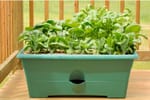Creating an eco-friendly home benefits not only the environment but also your wallet.
Adopting simple, sustainable practices and adjusting your daily habits can significantly reduce your carbon footprint and foster a healthier living space.
Transforming your home into a greener sanctuary is easier than you might think, and the positive impact on the planet and your lifestyle is truly rewarding.
1)) Use Energy-Efficient Appliances
One of the easiest ways to make your home more eco-friendly is by using energy-efficient appliances.
Look for ENERGY STAR-certified appliances, as they use less energy and water than traditional models.
Not only will this help reduce your utility bills, but it will also lower your carbon emissions.
Tips for Using Energy-Efficient Appliances:
- Choose ENERGY STAR Certified Appliances: Ensure you are purchasing appliances that have the ENERGY STAR label; these models meet energy efficiency guidelines set by the U.S. Environmental Protection Agency.
- Unplug When Not in Use: Many appliances consume energy even when turned off but still plugged in. To prevent this “phantom load,” unplug devices when they’re not in use or use a power strip to easily switch off multiple devices at once.
- Use Appliances During Off-Peak Hours: Run energy-intensive appliances, like washing machines and dishwashers, during off-peak hours, typically early morning or late evening, to reduce strain on the grid and save on energy costs.
- Regular Maintenance and Cleaning: Keep your appliances running efficiently by performing regular maintenance, such as cleaning refrigerator coils and checking seals on your dryer. This ensures they don’t use more energy than necessary.
- Opt for Multi-Functional Appliances: Consider investing in multi-functional appliances, like toaster ovens, which can perform the functions of several devices, reducing the overall energy consumption in your home.
By integrating energy-efficient appliances into your household, you can make a significant impact on both the environment and your budget.
These simple yet effective changes not only help conserve energy but also promote a more sustainable lifestyle.
Embrace these tips to start enjoying the benefits of a greener, more eco-friendly home.
2)) Install LED Light Bulbs
Another simple way to make your home more eco-friendly is by switching to LED light bulbs. LED bulbs use up to 80% less energy than traditional incandescent bulbs and last much longer, reducing the amount of waste generated from burnt-out bulbs.
Tips for Installing LED Light Bulbs:
- Choose the Right Brightness and Color: LEDs are available in various brightness levels (measured in lumens) and color temperatures (measured in Kelvins). Select bulbs that suit the room’s function—warmer tones for living areas and cooler tones for workspaces.
- Look for ENERGY STAR Certified LEDs: Similar to appliances, choosing ENERGY STAR-certified LED bulbs ensures that they meet higher energy efficiency standards, providing better performance and longevity.
- Replace High-Use Bulbs First: Start by replacing the bulbs in the most frequently used fixtures, such as in the kitchen, living room, and bathrooms, to maximize your energy savings immediately.
- Use Dimmable LEDs: Opt for dimmable LED bulbs to give you better control over lighting levels and reduce energy consumption. Ensure that your dimmer switch is compatible with LED technology.
- Recycle Old Bulbs Properly: Be sure to properly recycle your old incandescent or CFL bulbs. Many hardware stores and local recycling centers offer recycling programs for used bulbs to prevent them from ending up in landfills.
By transitioning to LED light bulbs, you can enjoy substantial energy savings and reduce your environmental impact.
LEDs not only last longer and use less energy but also offer versatility in brightness and color options to enhance your home’s ambiance.
Implementing these tips will help you light your home more efficiently while contributing to a greener planet.
3)) Reduce Water Usage
Conserving water is another important aspect of creating an eco-friendly home.
Install low-flow faucets and showerheads, fix any leaks promptly, and consider installing a rain barrel to collect rainwater for watering plants or washing cars.
Tips for Reducing Water Usage:
- Install Low-Flow Fixtures: Replace standard faucets and showerheads with low-flow versions, which can significantly reduce water consumption without compromising water pressure.
- Fix Leaks Promptly: Even small leaks can waste a considerable amount of water over time. Regularly inspect your home for leaks and fix them immediately to save water and prevent damage.
- Opt for Water-Efficient Appliances: Choose appliances like dishwashers and washing machines that are designed to use less water. Look for models that have a high-efficiency rating.
- Collect Rainwater: Set up a rain barrel to capture rainwater from your roof. This water can be used for gardening, washing your car, or other non-potable purposes, reducing the demand for your household water supply.
- Adopt Water-Saving Habits: Simple changes in daily routines, such as turning off the tap while brushing your teeth or taking shorter showers, can result in substantial water savings over time.
By adopting measures to reduce water usage, you can make a positive impact on both the environment and your utility bills.
Simple actions like installing low-flow fixtures, fixing leaks, and collecting rainwater contribute to significant water savings.
Embrace these tips to foster a more sustainable household while conserving one of our most precious natural resources.
4)) Compost Kitchen Waste
Instead of throwing food scraps into the trash where they end up in a landfill producing methane gas, start composting them instead.
Composting not only reduces waste but also creates nutrient-rich soil for gardening.
Tips for Composting Kitchen Waste:
- Set Up a Compost Bin: Choose an appropriate compost bin for your space, whether it’s an outdoor compost pile, a compost tumbler, or an indoor composting system. Ensure it has good ventilation and drainage.
- Know What to Compost: Add fruit and vegetable scraps, coffee grounds, eggshells, and yard waste to your compost bin. Avoid meat, dairy, and oily foods, as they can attract pests and produce unpleasant odors.
- Balance Green and Brown Materials: Maintain a healthy compost by balancing green materials (like kitchen scraps and grass clippings) rich in nitrogen with brown materials (like dried leaves and cardboard) rich in carbon.
- Turn the Compost Regularly: Aerate your compost by turning it regularly with a garden fork or a compost-turning tool. This helps speed up the decomposition process and prevents odors.
- Monitor Moisture Levels: Keep your compost moist, but not too wet. It should feel like a damp sponge. You may need to add water during dry periods or add more brown materials if it becomes too wet.
By composting kitchen waste, you can significantly reduce the amount of organic material that ends up in landfills, thereby mitigating methane gas production.
Composting transforms food scraps into valuable nutrient-rich soil that can enhance your garden's health.
Implementing these simple composting tips will help you manage waste more sustainably while contributing to a greener environment.
5)) Use Natural Cleaning Products
Many conventional cleaning products contain harmful chemicals that are not only bad for the environment but also for our health.
Switching to natural cleaning products made with ingredients like vinegar, baking soda, and essential oils can help reduce indoor air pollution and protect our waterways from toxic runoff.
Tips for Using Natural Cleaning Products:
- Make Your Own Cleaners: Create simple, effective cleaners using common household ingredients like vinegar, baking soda, lemon juice, and essential oils. These ingredients can tackle a variety of cleaning tasks without harsh chemicals.
- Read Labels Carefully: When purchasing natural cleaning products, ensure they do not contain hidden chemicals by reading the labels. Look for products certified by reputable environmental organizations.
- Use Essential Oils: Essential oils like tea tree, lavender, and eucalyptus have antibacterial properties and can be added to homemade cleaners for an extra boost. They can also provide a pleasant, natural fragrance.
- Opt for Multi-Purpose Cleaners: Choose natural multi-purpose cleaners that can be used on various surfaces, reducing the need for multiple products and making your cleaning routine more efficient.
- Reuse and Recycle Containers: Reduce waste by reusing old spray bottles and containers to store your homemade cleaners. Opting for concentrated cleaning solutions can also help lessen packaging waste.
Switching to natural cleaning products is a straightforward yet impactful way to create a healthier home and environment.
By making your cleaners, carefully selecting products, and incorporating essential oils, you can avoid harmful chemicals that compromise indoor air quality and contribute to toxic runoff.
Embracing these tips not only supports a sustainable household but also promotes overall well-being for you and your family.
6)) Invest In Solar Panels
If you're looking to take your eco-friendly efforts to the next level, consider investing in solar panels for your home.
Solar panels harness the power of the sun to generate electricity, reducing your reliance on fossil fuels and lowering your carbon footprint.
Tips for Investing In Solar Panels:
- Evaluate Your Home’s Suitability: Conduct an initial assessment to determine if your home is suitable for solar panels. Consider factors such as roof orientation, shading, and structural integrity to ensure optimal energy production.
- Calculate Energy Needs: Analyze your household's electricity consumption to understand how much energy you need to generate. This will help you decide the size and number of solar panels required.
- Research Solar Incentives: Look into available solar incentives, rebates, and tax credits offered by federal, state, and local governments. These can significantly reduce the upfront cost of installing solar panels.
- Choose a Reputable Installer: Select a certified and experienced solar panel installer by checking reviews, asking for recommendations, and ensuring they have the necessary licenses and insurance.
- Explore Financing Options: Investigate various financing options such as solar loans, leases, and power purchase agreements (PPAs). Some options might offer no upfront costs and flexible payment plans, making solar energy more accessible.
Investing in solar panels is a strategic choice that offers long-term environmental and financial benefits.
By assessing your home's suitability, understanding your energy needs, and taking advantage of available incentives, you can make a well-informed decision.
Selecting a reputable installer and exploring financing options further ensure a smooth and cost-effective transition to renewable energy.
Ultimately, adopting solar power reduces your carbon footprint and harnesses clean, sustainable energy from the sun, contributing to a greener future.
7)) Plant Trees And Native Plants
Planting trees and native plants in your yard not only adds beauty to your landscape but also provides a habitat for wildlife and helps sequester carbon dioxide from the atmosphere.
Tips for Planting Trees and Native Plants:
- Choose the Right Species: Select trees and native plants that are well-suited to your local climate, soil type, and light conditions. Native plants are more likely to thrive and provide essential benefits to local wildlife.
- Plan for Growth: Consider the mature size of trees and plants when planning your garden layout. Ensure there is enough space for roots and branches to grow, and avoid planting too close to buildings, power lines, or other structures.
- Water Wisely: Native plants typically require less water once established but need proper watering during the initial growth phase. Use drought-tolerant species and implement efficient irrigation practices to conserve water.
- Mulch and Fertilize Appropriately: Apply mulch around the base of trees and plants to retain moisture, suppress weeds, and regulate soil temperature. Use organic fertilizers to provide the necessary nutrients without harming the environment.
- Provide Habitat for Wildlife: Incorporate a variety of plants to create a diverse habitat for birds, insects, and other wildlife. Choose plants that produce nectar, seeds, and berries to support local ecosystems and enhance biodiversity.
Planting trees and native plants in your yard is a rewarding endeavor that enhances your property while supporting the environment.
By selecting the right species, planning for future growth, and implementing wise watering and fertilizing practices, you can create a sustainable and vibrant habitat for local wildlife.
These efforts contribute to carbon sequestration, water conservation, and the overall health of your ecosystem, making your garden a true testament to environmental stewardship.
8)) Reduce Single-Use Plastics
Single-use plastics like plastic bags, straws, and water bottles are major contributors to pollution in our oceans and landfills.
By switching to reusable alternatives such as cloth bags, metal straws, and refillable water bottles, you can significantly reduce your plastic waste.
Tips for Reducing Single-Use Plastics:
- Use Reusable Bags: Switch to cloth or other durable bags for your shopping needs. Keep a few in your car or bag to ensure you always have them on hand.
- Carry a Refillable Water Bottle: Invest in a high-quality, refillable water bottle to avoid purchasing single-use plastic bottles. Look for insulated options to keep your beverages at the desired temperature.
- Opt for Metal or Bamboo Straws: Instead of disposable plastic straws, use metal, bamboo, or silicone straws. Many come with carrying cases, making it easy to bring them with you.
- Choose Reusable Food Storage: Replace plastic wrap and disposable food containers with reusable alternatives made from materials like glass, silicone, or stainless steel. Beeswax wraps are an eco-friendly option for covering food.
- Buy in Bulk: Purchasing items in bulk reduces the amount of plastic packaging. Use your containers or bags at bulk food stores, and choose products with minimal or recyclable packaging.
Reducing single-use plastics is a simple yet effective way to minimize your environmental impact.
By incorporating reusable alternatives into your daily routine, you can significantly cut down on plastic waste and contribute to cleaner oceans and landfills.
Small changes, such as using reusable bags, water bottles, and straws, help protect wildlife and preserve natural resources.
These mindful choices contribute to a more sustainable and eco-friendly lifestyle, benefitting both the planet and future generations.
9)) Insulate Your Home
Proper insulation is key to reducing energy consumption in your home. Make sure that your walls, windows, doors, and attic are well insulated to keep warm air inside during winter months and cool air during summer months.
Tips for Insulating Your Home:
- Seal Gaps and Cracks: Inspect your home for any gaps or cracks around windows, doors, and walls. Use caulk or weatherstripping to seal these openings, preventing drafts and heat loss.
- Upgrade to Double-Glazed Windows: Consider installing double-glazed or energy-efficient windows. These types of windows provide better insulation, reducing heat loss in the winter and keeping your home cooler in the summer.
- Insulate Your Attic: The attic is a major point for heat loss. Ensure that it is well-insulated with materials like fiberglass, cellulose, or spray foam to maintain a consistent indoor temperature.
- Install Insulated Doors: Replace old or hollow-core doors with insulated or solid exterior doors. This upgrade helps in minimizing heat transfer and improving your home's overall energy efficiency.
- Use Thermal Curtains: Hang thermal or insulated curtains over windows to reduce heat loss during cold weather and keep your home cooler in the summer. These curtains add an extra layer of protection against temperature fluctuations.
Properly insulating your home is an effective way to enhance energy efficiency and maintain a comfortable indoor environment year-round.
By sealing gaps and cracks, upgrading windows, insulating your attic, and using thermal curtains, you can significantly reduce energy consumption and lower utility bills.
These measures not only contribute to a greener and more sustainable lifestyle but also increase the overall comfort and value of your home.
10)) Support Sustainable Brands
When shopping for furniture, clothing, household goods, or any other items for your home, look for brands that prioritize sustainability and ethical practices in their production processes.
Tips for Supporting Sustainable Brands:
- Research Brand Ethics: Before making a purchase, take the time to research the sustainability and ethical practices of the brand. Look for certifications such as Fair Trade, organic, or B Corp that indicate a commitment to responsible practices.
- Prioritize Quality Over Quantity: Choose products that are built to last rather than opting for cheaper, disposable items. High-quality products often have a longer lifespan, reducing the overall waste and environmental impact.
- Support Local Businesses: Buying from local artisans and smaller companies often means supporting more sustainable production methods. Local businesses are more likely to use eco-friendly materials and practices.
- Look for Transparency: Brands that are genuinely committed to sustainability tend to be transparent about their practices. Check for detailed information on their sourcing, production methods, and environmental impact on their website.
- Opt for Minimal Packaging: Choose brands that use minimal or recyclable packaging for their products. Avoid excessive plastic wrapping and opt for items packaged in sustainable materials like cardboard or compostable options.
Supporting sustainable brands is a powerful way to drive positive change in the marketplace.
By choosing companies that prioritize ethical practices, quality products, and eco-friendly materials, you can reduce your environmental footprint and advocate for a more sustainable future.
These mindful purchasing decisions help promote fair labor practices, reduce waste, and encourage businesses to adopt greener methods.
Your support for sustainable brands contributes to a healthier planet and a more just society.
Conclusion
Adopting eco-friendly practices at home is a meaningful journey that extends beyond immediate benefits, leading to lasting, positive impacts on both the environment and your well-being.
By starting with small, manageable changes such as utilizing energy-efficient appliances and reducing water usage, you lay the groundwork for a more sustainable lifestyle.
Embracing composting, natural cleaning products, and solar energy not only diminishes your carbon footprint but also induces a sense of accomplishment and stewardship towards the planet.
Planting trees, reducing single-use plastics, and supporting sustainable brands foster a broader culture of environmental responsibility, showing that individual actions can culminate in significant change.
Proper insulation and other energy-saving measures contribute to a more efficient and comfortable home, resonating with the principles of sustainability.
The cumulative effect of these actions creates a ripple of positive change, benefiting your immediate living environment and instilling eco-conscious values for future generations.
Embark on this transformative journey today, knowing that each step you take propels us towards a greener, healthier, and more resilient world.
Download Our Free E-book!







